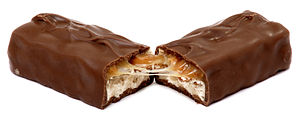- Chocolate bar
-
A chocolate bar is a confection in bar form comprising some or all of the following components: cocoa solids, cocoa butter, sugar, milk. The relative presence or absence of these components form the subclasses of dark chocolate, milk chocolate, and white chocolate. In addition to these main ingredients, it may contain emulsifiers such as soy lecithin and flavors such as vanilla. There are many varieties of chocolate; milk chocolate, dark chocolate, white chocolate, peanut butter chocolate, and many more.
A candy bar (called a chocolate bar in Australian English, British English, Canadian English, Indian English, Irish English, New Zealand English and South African English) is a form of confectionery usually packaged in a bar or log form, often coated with chocolate, and sized as a snack for one person. But within that term, a wide variety of products exists, ranging from solid chocolate bars to multiple layerings or mixtures of ingredients such as nuts, fruit, caramel or fondant containing no chocolate.
Certain brands of chocolate bars and candy bars are sold as being for nutritional supplementation purposes. These bars contain protein and various vitamins while still retaining a sweet taste.
Contents
History
Up to and including the 19th century, candy of all sorts was typically sold by weight, loose, in small pieces that would be bagged as bought. The introduction of chocolate as something that could be eaten as is, rather than used to make beverages or desserts, resulted in the earliest bar forms, or tablets. At some point, chocolates came to mean any chocolate-covered candies, whether nuts, creams (fondant), caramel candies, or others. The candy bar evolved from all of these in the late-19th century as a way of packaging and selling candy more conveniently, for both buyer and seller. This "convenience" did not include price, of course, as the buyer had to pay for the packaging. It was considerably cheaper to buy candy loose, or in bulk.
In 1847, the Fry's chocolate factory, located in Union Street, Bristol, England, molded the first ever chocolate bar suitable for widespread consumption. The firm began producing the Fry's Chocolate Cream bar in 1866. Over 220 products were introduced in the following decades, including production of the first chocolate Easter egg in UK in 1873 and the Fry's Turkish Delight (or Fry's Turkish bar) in 1914. In 1896 the firm became a registered private company. It was run by the Fry family, with Joseph Storrs Fry II, grandson of the first Joseph Storrs Fry, as the chairman.
Although chocolate bars and candy bars had their beginnings in the 19th century, it was in the early-20th century that this confectionery commercial venture grew most rapidly. The first wrapped chocolate bar, which is still being produced, was the Hershey bar, produced by The Hershey Company in 1900[citation needed]. A number of the bars developed in that era still exist in relatively unchanged form (except for miniature versions such as Hershey's Miniatures chocolate bars released in 1939). In the U.S., most candy bars started out priced at ten cents, down to five cents during the Great Depression, and back to ten after World War II. This price remained stable until the late 1960s.
During the first half of the 20th century in the U.S., there were thousands of different candy bars being manufactured and distributed locally or regionally by small candy companies. Some of these still survive, but a few major manufacturers have taken over the marketplace, buying up smaller companies and reproducing the most popular of their candy bars. Today candy bars are made and consumed all over the world, and manufactured to local tastes and environmental conditions.
Armenia held the record of producing the world's largest chocolate bar weighing in at 9,702 lbs.[1][2]
Manufacturers
- Cadbury
- Ferrero
- Ganong Bros.
- Goetze's Candy Company
- The Hershey Company
- Idaho Candy Company
- Ion
- Kraft Foods
- Lake Champlain Chocolates
- Loacker
- Mars, Incorporated
- Nestlé
- Necco
- Peter Paul Candy Manufacturing Company
- Prestat
- Ritter Sport
- Sucre Sweet Boutique
- Tootsie Roll Industries
- World's Finest Chocolate
Brands
See also
- Granola bar
- Energy bar
References
- ^ Mailonline Reporter (9/12/10). "And the country with the world's biggest chocolate bar is ... Armenia! Read more: http://www.dailymail.co.uk/news/article-1311074/And-country-worlds-biggest-chocolate-bar---Armenia.html#ixzz1aEaQSz6H". Mailonline. http://www.dailymail.co.uk/news/article-1311074/And-country-worlds-biggest-chocolate-bar---Armenia.html. Retrieved 8 October 2011.
- ^ "Armenia produces world's biggest chocolate bar". USA Today. 9/11/2010. http://www.usatoday.com/news/offbeat/2010-09-11-chocolate_N.htm. Retrieved 8 October 2011.
- Almond, Steve (2004) Candyfreak, Algonquin Books of Chapel Hill, ISBN 1-56512-421-9
- Broekel, Ray (1982) The Great American Candy Bar Book, Houghton Mifflin Co., ISBN 0-395-32502-1
- Richardson, Tim (2002) Sweets: A History of Candy, Bloomsbury, ISBN 1-58234-307-1
External links
Chocolate Background Outline of chocolate · History of chocolate · Health effects of chocolate · History of chocolate in Spain
Origins Varieties Types of chocolate · Chocolate chip · Chocolate milk · Fudge · Chocolate bar · Hot chocolate · Chocolate ice creamChemicals See also Categories:- Candy bars
- Confectionery
- Snack foods
Wikimedia Foundation. 2010.

